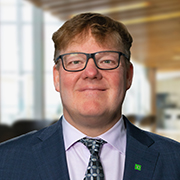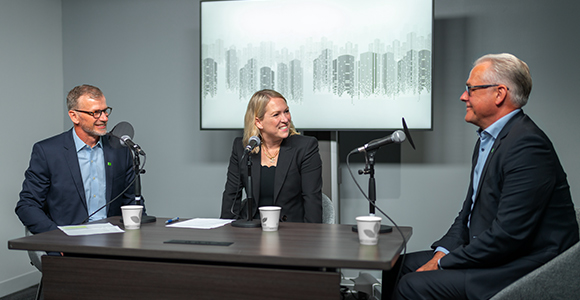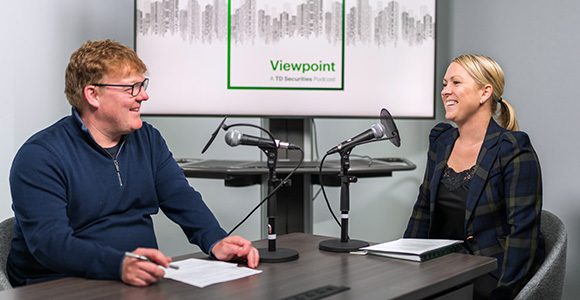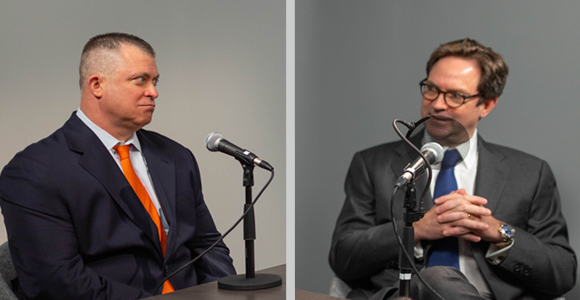The Rapid Evolution of Fixed Income Trading

Host: Peter Haynes, Managing Director and Head of Index and Market Structure Research, TD Securities
Guests: Martin Mannion, Managing Director and Co-Head of Automated Trading, TD Securities and Matt Schrager, Managing Director and Co-Head of Automated Trading, TD Securities
On the one-year anniversary of TD's Headlands Tech Global Markets acquisition, Peter Haynes talks electronification with Matt Schrager and Martin Mannion. They tackle the nuances of e-trading in fixed income vs. equities markets, the interplay between ETFs and portfolio trading, and the key steps of becoming a major liquidity provider in investment grade credit.
Listen to additional episodes for more perspectives from a variety of thought leaders on key themes influencing markets, industries and the global economy today.
[MUSIC PLAYING]
NARRATOR: Welcome to Viewpoint, a TD Securities podcast. Listen in as we draw perspectives from a variety of thought leaders on key themes influencing markets, industries, and the global economy today. We hope you enjoy this episode.
PETER: Welcome to Viewpoint, a TD Securities podcast where we discuss issues impacting capital markets. My name is Peter Haynes, and I'll be your host for today's episode where we're going to dive in a little bit on electronic trading and fixed income, and other related markets, including municipal bonds.
Today, I'm joined by two new TD Securities employees who we're actually just celebrating their one-year anniversary with our firm. Matt Schrager and Marty Mannion came to TD via an acquisition that was made that closed on July 1, 2021, of an electronic trading firm by the name of Headlands. Marty, Matt, thanks for joining me today.
MARTY: Thanks, Peter.
MATT: Thanks, Peter. Good to be here.
PETER: So just before we get started, as I say, we just celebrated the one-year anniversary of Headlands joining TD Securities. Can you tell us a little bit about your backgrounds, and what brought TD Securities to Headlands, and how did that acquisition come about?
MARTY: This is Marty Mannion, happy to kick this off. I've spent my career in electronic trading. I started at NASDAQ during the height of the dotcom boom in 2000. I then moved to Citadel in 2004. Citadel, as many people know, is a large hedge fund in Chicago. And our group helped to build out equity and options market-making businesses, which today are the largest in the world.
In 2013 I joined my our previous colleagues at Citadel who had founded a firm called Headlands, where I joined to help build out a fixed-income market-making business in municipal and corporate bonds in partnership with Matt Schrager.
MATT: Yeah, thanks, Marty. I started my career at DRW, which is another large proprietary trading firm based in Chicago. I was initially focused on the software development side of the market, focused on building fixed-income, pricing analytic type software.
I was there for about a year and a half, and then I came over to Headlands to work with Marty to build out our automated fixed-income business. And I've been working with him and our team here ever since. And I focused more on the quantitative and technical aspects of the business.
MARTY: And, Peter, you asked about what brought TD and Headlands together. I think I can speak for Matt in that we both are thrilled to be part of the TD family. As you mentioned, it's been a year. We had built the largest market-making business in the municipal market at Headlands.
One of the real constraints on growing that business was access to capital and really being able to scale the business with institutional clients. And really, the ambition we had was to grow our municipal business into investment-grade corporate bonds, and then into other fixed-income related products.
And TD was a perfect match to do that where we could marry the electronic trading and automation capabilities that we had built out and scaled out at Headlands with all of the great assets that exist at TD, with a global footprint, access to multiple markets, obviously a great balance sheet and a great reputation with clients across many, many different asset classes, so excited to talk a little bit more about that today.
PETER: It seems to me it's a marriage made for both parties. After all, TD Securities, like any other major bulge bracket dealer, is going to need to understand and be competent, actually expert in electronic trading in all asset classes. My background, as you guys know, is in equities. And I would argue if anything, equities is at the equilibrium in terms of the electrification of its business, and the balance between electronic trading and human trading.
If we're thinking about a baseball game right now, what inning would we be in terms of the markets that you mentioned, municipals and also investment-grade credit, in terms of where those asset classes would be in that journey?
MATT: It's funny. If you had asked that question three years ago, I would have said the top of the first. We have probably now made it to-- I don't know, Marty, what you think-- but maybe like the third inning. And it depends very much on which market you look at.
Investment-grade credit, for example-- if you go back in time, I want to say four or five years, something like that, 15% volume was done electronically. As of late, it's more like 40%. So there's been a massive shift in the last few years towards electronificaiton. And if anything, that trend is only accelerating, not going the other way.
Now if you look at munis, for example, where we currently have the largest footprint, munis are still around 18% of volume is electronified. And that number has grown over the last few years. But in our opinion, there is just no world in which that number doesn't continue to grow meaningfully. And we think it will follow a similar trajectory to what you're seeing in credit.
Now, do we ever end up in the same place that equities or on-the-run Treasury futures are, where things are extremely automated, extremely latency sensitive? No, I don't think that we do. There are important structural differences between those markets and our markets.
Just one little example would be in equities, you would know better than me, Peter, but there's a few thousand liquid equities in the US. In munis alone, even ignoring all other fixed-income asset classes, there's well north of a million unique symbols. And so there's just massive structural differences to the markets. So I don't think that will ever end up in quite that level of extreme automation. But I do think we will move very materially in that direction. And we are seeing that now.
PETER: You mentioned electronificaiton in the munis market and also in the credit market. For our listeners, can you explain what the difference is between what we might call an ultra-low-latency market like equities, or maybe less-low-latency marketplaces like munis and credit?
Obviously, DRW and Citadel, firms that you guys used to work for, are leaders of the pack in what we would call ultra-low latency. But I'm curious, how does that work with respect to the munis market and the credit market? Why is there a difference between equities and the way electronificaiton is happening in munis and credit?
MATT: Yeah, that's a good question. And I think part of it comes down to maturity of the market and the time that people have been focused on this, automating equities for decades at this point. And the market has therefore gotten very efficient.
And, again, because there's only so many individual symbols, there's a lot of focus and attention on each one of them, to the point where you now have literally competition in the microsecond, sub-second range for orders or for trading opportunities in equities, in futures, et cetera.
If you contrast that with munis for example, the predominant market structure in munis and in credit is the RFQ. Most volume happens via RFQ. So an RFQ is essentially an auction. Somebody says, hey, I've got this bond, and I'd like to sell it. Market, what will you pay me for it?
And at munis, those RFQs are typically open for hours. And so almost definitionally, there's almost no latency sensitivity. There's no urgency, really, to respond to that order, because it's there for hours.
In credit, that time frame is more like 5 to 10 minutes. So it's a lot faster, and it does keep shrinking over time. But it's nowhere near the nanosecond, microsecond range that you see in equities, in futures. And I think because of the market structure differences between these two markets, I doubt that you will ever quite get to that spot.
MARTY: Yeah, and just to jump on the back of Matt's comments, one thing that makes fixed income quite a bit different than equities or futures or options, for example, is that in those other markets they're very exchange-centric. You have a centralized place or venue where you deliver price discovery, where people come, buyers and sellers can come together.
And you have robust quoting information and market data that gets generated off of that venue. Whereas in fixed-income markets, it's very dealer-centric. So you're trading typically bilaterally. It makes the market much more fragmented. And then to Matt's point earlier about the sheer number of products, again, just to put a fine point on it, you have a few thousand equities. You may have tens of millions of trades in any given day across those few thousand equities.
In the muni market, you have a million-plus CUSIPs, and you may have 40,000 trades in a particular day. So there's less opportunity for buyers and sellers to continuously come together the way they would on a centralized venue. And so you rely much more on the dealer function for price discovery through mechanisms like the RFQ that Matt described to try to elicit interest or solicit interest from market participants in any given order or security.
PETER: I know there was a running joke at the SEC a few years ago. There was something like 2,000 SEC employees that were focused on the equity market, and only one that was focused on fixed income. I know it's changed in the past few years. And I actually want to talk a little bit about Chair Gensler and his agenda at the SEC, which I think equity participants would argue is very aggressive.
One of the aspects that Chair Gensler is pushing for is actually a new definition from the SEC on best execution. What does best execution in the context of the munis and fixed-income market mean, given you have RFQs that are regular? Is there a tape? Is there a requirement that you always have to get the best price for your customer? Can you explain a little bit about that process, especially given that it's so geared towards retail? And retail is obviously something that Chair Gensler has started to muse about in terms of equity best execution.
MARTY: Yeah, absolutely. And, Peter, you'll find this just probably hard to believe, but prior to 2016, there was not a best execution rule in effect for these fixed-income markets. So it simply didn't exist. And I think it goes to the point you made about the amount of scrutiny or focus on these markets versus, say, equities.
Interestingly, we actually got into this business when we were at Headlands, in large part because we felt that the regulatory regime was shifting. This was back in 2011, 2012. The SEC put together a very detailed market structure report where they took a look at the fixed-income markets and said, OK, are there things that we can borrow from the equity markets and apply them to fixed income to make them more efficient, especially for retail investors? And the muni market is probably the most retail-centric market that there is in the US, or maybe even the world.
Over the last few years, a combination of the SEC, FINRA, and the MSRB have implemented really some pretty significant changes, best execution being one, others are better clarification around order handling protocols, another being disclosures of markup and markdowns, which was something that didn't exist prior to just a few years ago. And so all of that has made the fixed-income markets, I think, a fairer place to execute.
When we first entered the market, one of the things we really grappled with was, in the RFQ process, the ability to compete for retail orders and provide liquidity and fair pricing to deliver a best execution experience to retail investors. Prior to the implementation of some of these rules, you often saw lots of behavior which we refer to as filtering, where competing dealers would be blocked from bidding on bonds from retail orders from other dealers.
You also had a-- a pretty prevalent practice was what we would call last look, where you could initiate an auction and then a dealer would step in after collecting competing prices from other dealers. And so some of these practices still exist today. But I think we've seen in the market make tremendous strides in becoming a fairer and more equitable place for retail investors in particular.
And you can really see that in effective spreads. Spreads have really tightened quite dramatically. And there are consolidated tapes in fixed income. Both the MSRB and FINRA have tapes that they operate. And so there is transparency around pricing.
I think some of the focus from Gensler and the SEC today and the fixed-income world is around, how do we improve the transparency of the tape? Are there things that we can do to further improve the best ex experience? There's also talk about pretrade transparency and bringing that to the fixed-income markets, which doesn't really exist today.
So I think that's really the focus of the SEC in this environment. And, certainly, they have a big mandate, and they're trying to do quite a bit in the equity world, and I think in the fixed-income world as well. So it'll be interesting to see one of these rules actually get implemented.
PETER: It's interesting. In equities, one of the suggestions that Chair Gensler has and is pushing for is that every retail order enter an auction, because right now those orders trade off exchange. And there's no opportunity to compete for those retail orders. Personally, I think the auction idea is not a good one in the context of a multiple exchange framework.
But we're also seeing equity markets come up with so-called periodic auctions or micro auctions. And they're growing in Europe, and there's some talk about that growth potentially happening in North America. So it is interesting to see all these markets are evolving. And as they change, certainly in the case of the fixed-income world, the world that you're now living at at TD Securities, so prior to that at Headlands, it's obvious that there is an incredible amount of influx behavior.
Just as we finish up here, one part of the market that has grown dramatically is exchange-traded funds, at least in the context of on-exchange volume. Most Exchange-Traded Funds, or ETFs as they're known, now stem across every single asset class in every corner of the market you could possibly think of. Obviously, that's run into the markets that you're active in.
And one of the developments that's come on the back of the growth in ETFs, particularly for the fixed-income asset class, is the growth of so-called portfolio trading, something that's been around for a long time in equities, and obviously now growing in your space. How has portfolio trading changed the world that you live in, and what percentage of the market does portfolio trading represent today? Where do you think that'll get to?
MATT: Yeah, that's a good question. Portfolio trading has definitely been one of the biggest evolutions in the market over the last few years. Again, if you asked me this question about three years ago, I think the answer to your question would have been approximately 0%.
Nowadays, I think the latest figure is that portfolio trading accounts for about 8% of volume in the markets, which is a really rapid rise. And I think that you'll keep seeing that number go up. There's a lot of benefits to buy side in terms of workflow improvements. They know they're going to get done on the whole list, as opposed to, if they were to put out all of these bonds individually for RFQs, maybe there are certain bonds they wouldn't get responses on. So it makes their workflow easier.
And then you also mentioned ETFs. And there's actually a very natural interplay between portfolio trading and ETFs, because what a lot of the good liquidity providers do in this space is they'll take a portfolio, and some chunk, sometimes a lot of it, will be ETF eligible, meaning that you can execute the ETF creation or redemption mechanism, which we could talk about another time.
But, basically, you can convert a big chunk of the portfolio of bonds into ETF shares, and then sell the ETF shares. It's a nice, natural way to close out the risk that you're taking on from portfolios. Oftentimes when we talk about the steps to become a major liquidity provider in investment-grade credit, we talk about three pillars.
The first is the cash bonds themselves. The second is the ETFs, which are massively growing, as you mentioned. The third is portfolio trading. And there's a natural symbiotic relationship between all of those things. Portfolio trading has certainly growing rapidly, and I don't think that there's really any signs of that slowing down in the near future.
PETER: I think back a lot to how portfolio trading evolved in the early 2000s in the equity world. It really did evolve as a tool to make things easier for the buy side. But it also, at some point, evolved into a tool where investors could take an illiquid position that they couldn't get rid of, and wrap it into a portfolio trade with a whole bunch of more liquid names, and pass the illiquid position on to a dealer, which you then can't get rid of. Has this behavior started to happen in fixed income?
MATT: Absolutely. Yes, that is definitely-- when I mentioned that there might be some CUSIPs that otherwise might not get bids or offers individually, that's exactly what I'm referring to you. And so, look, from our perspective, we're a liquidity provider.
We want to provide the best service that we can to our clients. Of course, we're going to build the fact that there's some illiquid or difficult CUSIPs into our pricing for the portfolio, but at least they get a price back. At least they can transact. So I think in that sense, it's a positive development for the market.
PETER: Yeah, we used to refer to those as scuds. There would be a scud in some of these portfolios, but you had to price in that risk, that illiquidity risk. You're absolutely right. So as we wrap up here, on behalf of the organization, welcome to TD Securities. Congratulations on your one-year anniversary, and thanks very much for spending some time with us today explaining how the fixed-income markets are electronifying.
And we certainly look forward to having you back on the show down the road, perhaps at your second anniversary where you can give us an update on how quickly your markets continue to change. Thanks for coming on today.
MATT: Thanks, Peter.
MARTY: Thanks, Peter.
NARRATOR: Thank you for listening to Viewpoint, a TD Securities podcast. If you enjoyed this episode, subscribe to this series on Apple Podcasts or on your favorite podcast platform. For more thought leadership content, visit TDSecurities.com, and follow us on LinkedIn for all the latest TD Securities updates. For relevant disclaimers to this podcast, please refer to the Viewpoint episode page on our website.
This podcast should not be copied, distributed, published or reproduced, in whole or in part. The information contained in this recording was obtained from publicly available sources, has not been independently verified by TD Securities, may not be current, and TD Securities has no obligation to provide any updates or changes. All price references and market forecasts are as of the date of recording. The views and opinions expressed in this podcast are not necessarily those of TD Securities and may differ from the views and opinions of other departments or divisions of TD Securities and its affiliates. TD Securities is not providing any financial, economic, legal, accounting, or tax advice or recommendations in this podcast. The information contained in this podcast does not constitute investment advice or an offer to buy or sell securities or any other product and should not be relied upon to evaluate any potential transaction. Neither TD Securities nor any of its affiliates makes any representation or warranty, express or implied, as to the accuracy or completeness of the statements or any information contained in this podcast and any liability therefore (including in respect of direct, indirect or consequential loss or damage) is expressly disclaimed.

Peter Haynes
Managing Director and Head of Index and Market Structure Research, TD Securities

Peter Haynes
Managing Director and Head of Index and Market Structure Research, TD Securities

Peter Haynes
Managing Director and Head of Index and Market Structure Research, TD Securities
Peter joined TD Securities in June 1995 and currently leads our Index and Market Structure research team. He also manages some key institutional relationships across the trading floor and hosts two podcast series: one on market structure and one on geopolitics. He started his career at the Toronto Stock Exchange in its index and derivatives marketing department before moving to Credit Lyonnais in Montreal. Peter is a member of S&P’s U.S., Canadian and Global Index Advisory Panels, and spent four years on the Ontario Securities Commission’s Market Structure Advisory Committee.

Martin Mannion
Managing Director and Co-Head of Automated Trading, TD Securities

Martin Mannion
Managing Director and Co-Head of Automated Trading, TD Securities

Martin Mannion
Managing Director and Co-Head of Automated Trading, TD Securities
Martin co-heads TD Securities Automated Trading (“TDSAT”) along with Matt Schrager. Since 2013, Martin has served as Co-CEO of Headlands Tech Global Markets (subsequently acquired by TD Securities and converted into TDSAT). Prior to this role, Martin was Chief Operating Officer (COO) and Managing Director for Citadel Execution Services, and served as a Board Member for DirectEdge Holdings, EASDAQ, and NYSE Amex. Prior to Citadel, Martin worked in the Transaction Services group at the NASDAQ Stock Market.

Matt Schrager
Managing Director and Co-Head of Automated Trading, TD Securities

Matt Schrager
Managing Director and Co-Head of Automated Trading, TD Securities

Matt Schrager
Managing Director and Co-Head of Automated Trading, TD Securities
Matt co-heads TD Securities Automated Trading (“TDSAT”), overseeing quantitative research and software development for TDSAT’s automated trading businesses. Matt joined Headlands Tech Global Markets (subsequently acquired by TD Securities and converted into TDSAT) in 2015 as a trader and software developer, and over time transitioned into a leadership position focused on quantitative and technical aspects of the business. During his time at TDSAT, Matt has helped architect TDSAT’s pioneering fixed-income automated trading platform, growing the business into a leading liquidity provider in the space.




